The first step to launching a successful campaign on YouTube starts with keyword research. This lesson helps you find and analyze potential keywords to rank for on YouTube.
This article is part of our free YouTube Growth Course. In total, there are four lessons in this course. This is part 1.
- 👉 You're here: Part 1. YouTube Keyword Research: How To Get More Views?
- Part 2. How To Create Engaging YouTube Videos That Rank Higher
- Part 3. YouTube SEO 101: How To Boost Your Videos Search Ranking
- Part 4. Effective YouTube Video Promotion: Strategies to Boost Reach
Creating videos focused on a specific topic or a niche that people are actively searching for is perhaps the quickest route to YouTube growth and success.
In simpler terms, you won't have to rely on your content going viral or word-of-mouth to generate views.
Many creators often overlook the fact that YouTube is not just a social media platform. It's actually the second-largest search engine in the world, right after Google.
– Adam Moore, Co-founder of SocialPlus
Just picture this: If one of your videos ranks within the top 3 results for a keyword with over 2,000 monthly searches, you'll continuously attract organic views month after month without spending a dime.
This not only boosts your viewer count but also attracts more engaged subscribers and enhances overall viewer interaction.
Sounds fantastic, doesn't it? In our YouTube Growth Course, we'll guide you through the best strategies for optimizing video rankings, ensuring your success on YouTube.
What is Keyword research?
Keyword research is all about discovering the most effective keywords for your videos, channel, and even budget.
This step is crucial for several reasons, and you can break it down like this:
- You should avoid trying to rank for keywords that people aren't actively searching for.
- Going after highly competitive keywords can be tough for beginners, unless you're willing to invest in promotions.
These are common pitfalls for beginners, with the second one resulting in your video getting lost in the sea of content.
We don't want that to happen, do we? 🙂
Have a niche yet?
Before we dive into keyword research, it's important to have a clear idea of the theme or focus for your content and channel.
If you're still in the early stages of starting out, I suggest checking out the article below that discusses how to find a niche and the advantages of having a niche compared to creating lifestyle content.
Additionally, remember that keyword research should be tailored to each new video you upload.
Therefore, it's a smart move to bookmark this post for future reference. 😉
Once you've determined the topic of your next video, you can begin thinking about what terms or keywords people might use when searching for your video on YouTube.
The Challenge of Growing as a Lifestyle Vlogger
I strongly advise choosing a niche as the foundation for your videos because people actively search for content within these specific niches.
Now, let's talk about lifestyle vlogging.
The landscape for lifestyle vlogging is becoming increasingly crowded, and it poses challenges when it comes to potential growth.
Unless you're a well-known celebrity or lead an exceptionally captivating life, it's crucial to ask yourself: "Why would people want to watch my daily life?"
As you can imagine, only a handful of individuals are searching for something like: "[insert your name] daily life"
This means that growing an audience through lifestyle vlogging can be quite challenging, primarily relying on going viral and word-of-mouth, which can be a lengthy process.
In essence, if people aren't actively searching for your videos, you won't benefit from regular organic views through search results.
On the other hand, if you create content centered around a specific topic that you are knowledgeable about and target keywords with existing search demand, your growth prospects become significantly more accessible and expedited.
Consider the Competition
When you're on the hunt for keyword ideas, it's crucial to understand that established YouTubers in your niche and newcomers don't start from the same position.
Big YouTubers can afford to go after highly competitive keywords because they already possess the authority, viewership, and engagement to propel their videos to the top of search results.
In most cases, it's nearly impossible to compete with them unless you invest in promotions.
But before you get discouraged and conclude that competing with well-known YouTubers is a lost cause, hang on and hear this out.
Instead of going head-to-head with them, you can target keywords that are less competitive. This is what we call long-tail keywords.
These are topics that the major YouTube channels aren't focusing on as much, providing you with an opportunity to deliver content that viewers can't easily find elsewhere.
How to generate keyword ideas
To analyze keyword search volumes effectively, you need a comprehensive list of keywords.
Generating such a list can be done through various methods, some of which are free, while others require a small investment.
Some methods require manual effort, while certain tools can automate the process, providing you with keyword ideas and search volumes based on a single term you provide, ultimately saving you time.
We'll explore all the methods below!
Begin by creating a new Excel file or using your preferred note-taking app to compile potential keywords. This document will serve as your keyword list. Aim to gather around 20-30 keywords or more, depending on your needs.
1. YouTube Search Suggestions (Free)
One of the easiest and cost-free methods for uncovering fresh keyword ideas is by tapping into YouTube's Search suggestions.
Here's how to do it:
- Go to YouTube.
- Enter a word or phrase relevant to your video content in the search field.
As you can see, YouTube will promptly provide you with a list of keyword ideas closely related to your input.
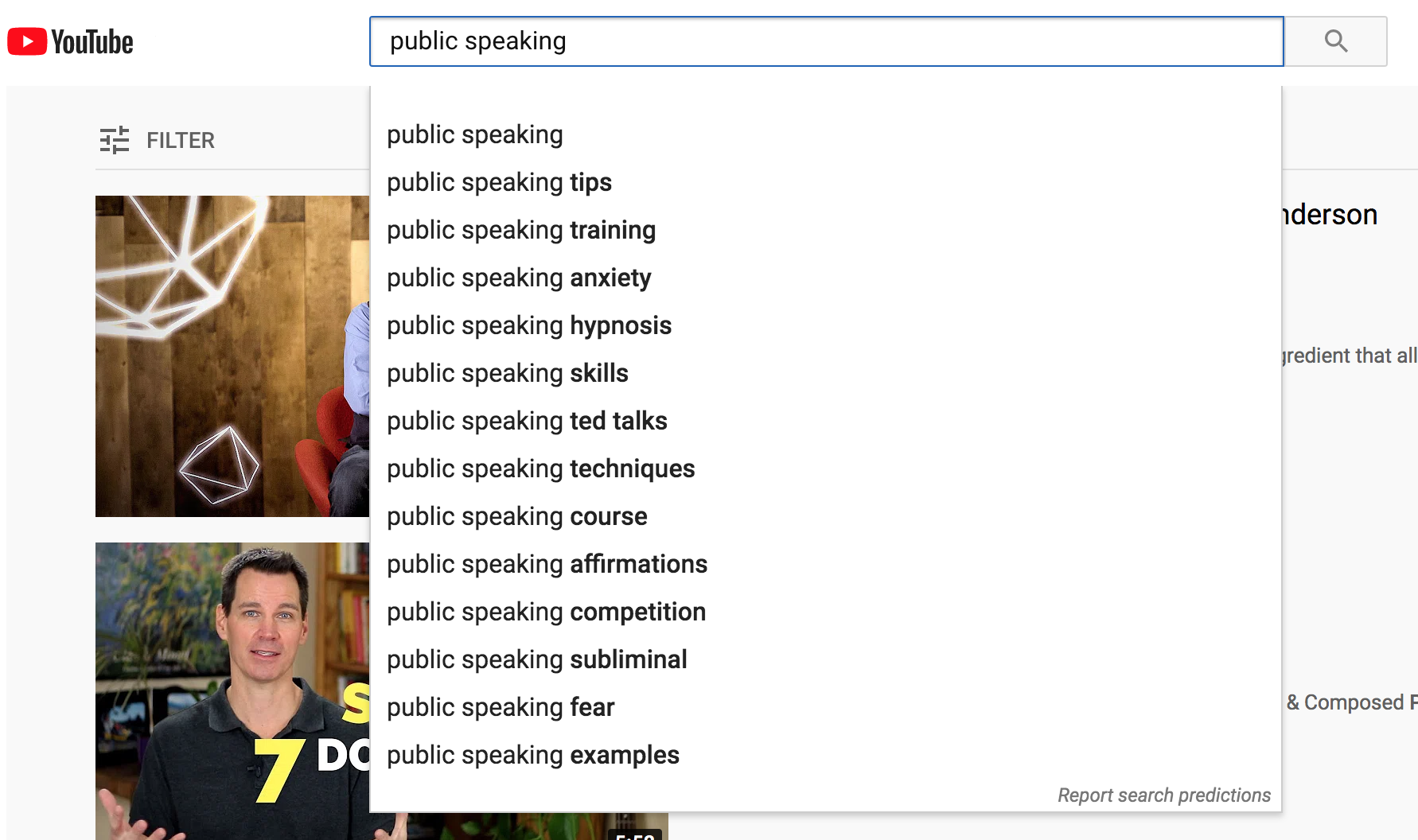
These suggestions hold significant value because they represent terms actively searched for on YouTube, indicating their popularity.
YouTube wouldn't display these suggestions if they weren't in demand.
2. Look at your competitors
If you're looking for trending video and keyword ideas, analyzing what successful competitors are doing is another great approach. Here's how you can do it:
- Find a popular channel in your niche, one that's thriving.
- Click the "Videos" tab and sort by "Most popular." This reveals their top-performing videos, ranked by the number of views.
When a video already boasts a substantial number of views and engagement on YouTube, it's likely because the video has been strategically optimized for a popular keyword.
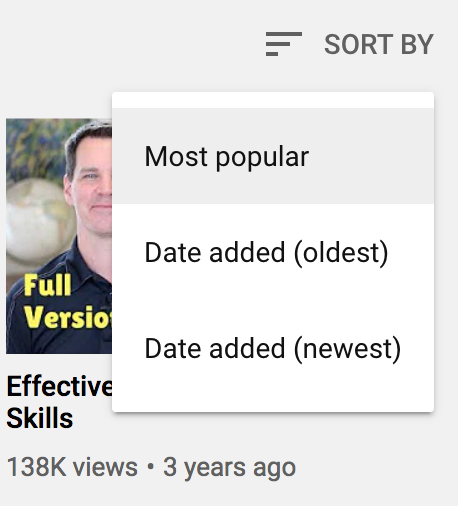
The next step is choosing a video that you can create an engaging and valuable video around.
We'll look deeper into this topic in the next lesson on crafting engaging videos that rank higher.
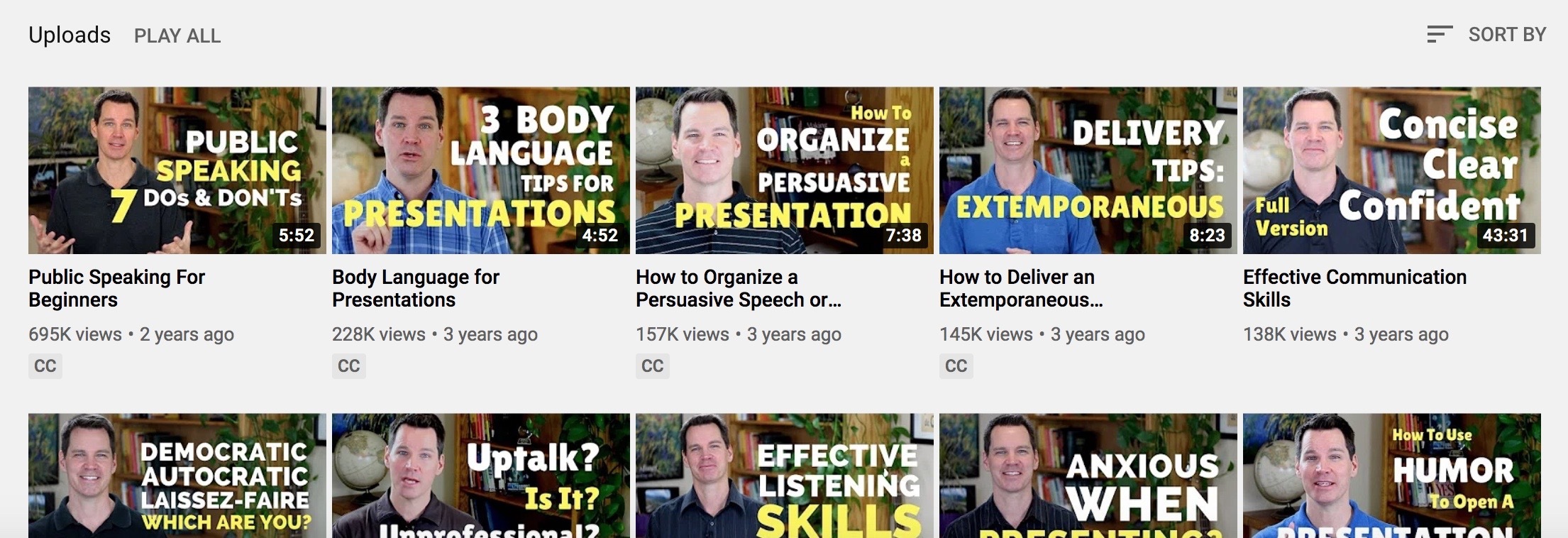
Uncovering the keywords
Now, let's uncover the keywords that the chosen video has been optimized for.
This is pretty straightforward: just look at the keywords in the video's title, description, and video tags.
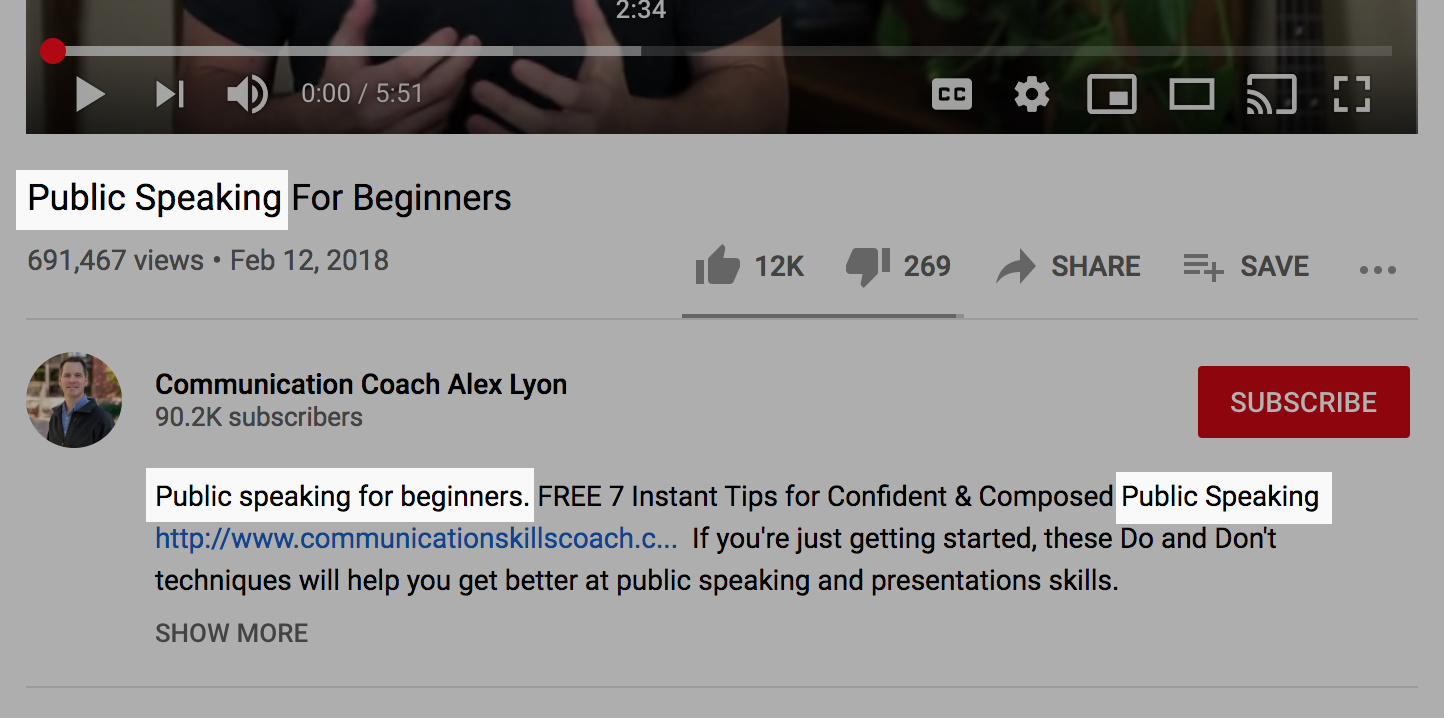
For instance, in this video, it's clear that two keywords have been optimized naturally: "public speaking" and "public speaking for beginners". Pretty clever. 🙂
The former is more competitive, while the latter is a long-tail keyword, making it a bit easier to rank for.
Over time, if the video maintains high audience retention and meets YouTube's algorithm ranking factors, it may rank for related keywords and appear in recommendations.
Remarkably, this video now holds the #2 spot for "public speaking".
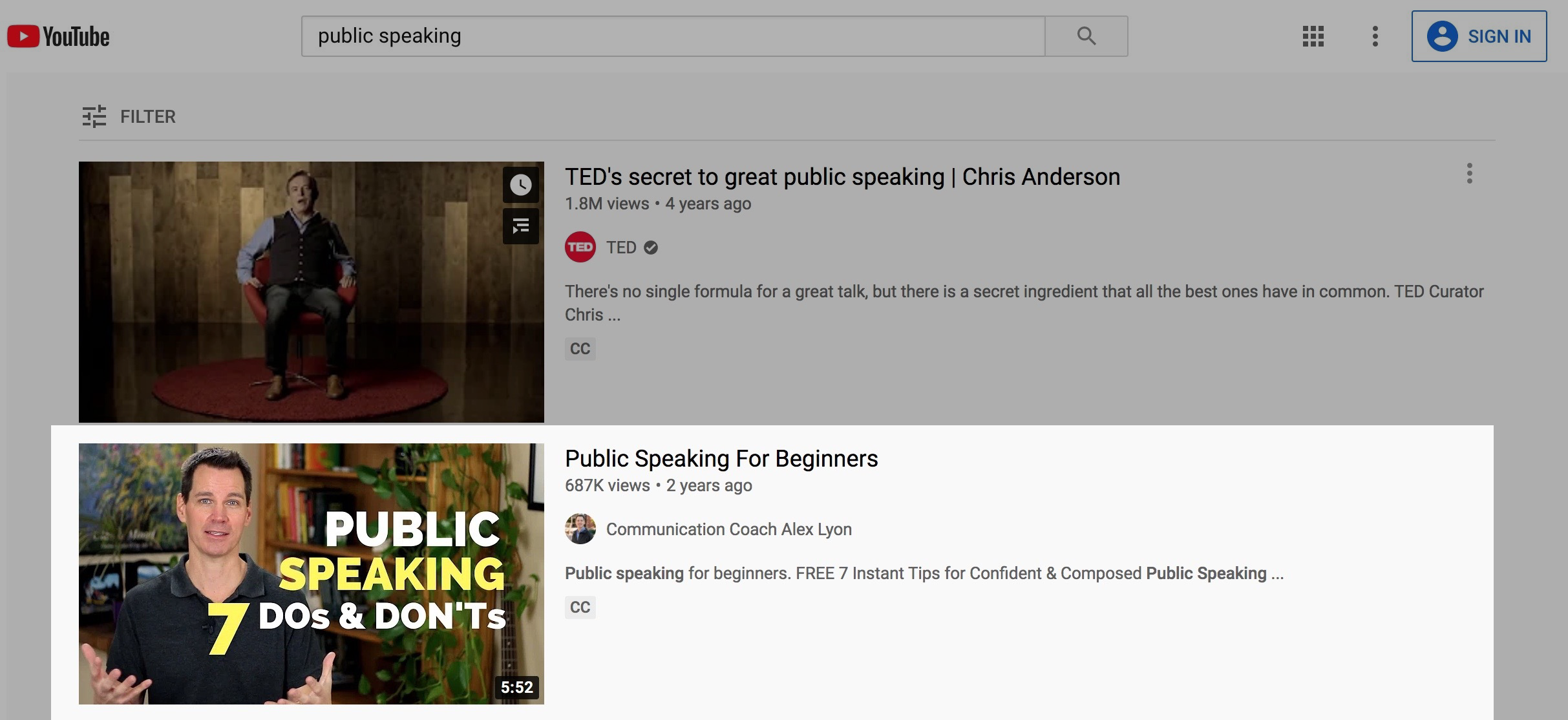
Heck, it even ranks in Google Search!
Speaking of Google Search, did you know that YouTube is owned by Google?
Consequently, your YouTube videos can also rank in Google Search, potentially boosting your views three to five times.
Just like this:
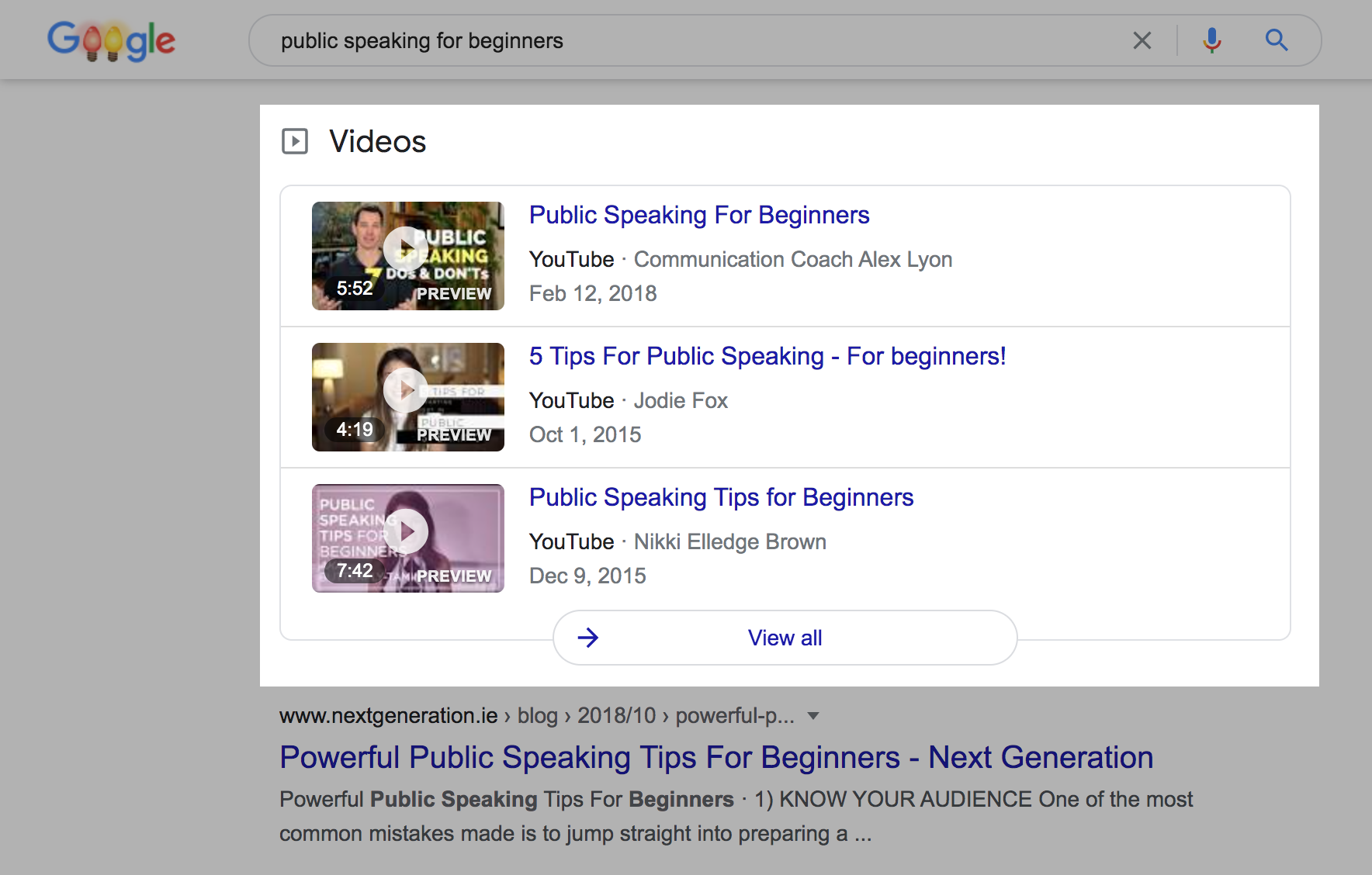
Why is this significant?
If you optimize your video around a keyword that lacks video results in Google, you'll only receive traffic from YouTube.
Google typically displays videos in search results for specific topics such as:
- How-to guides
- Product reviews
- Fitness or sports
- Tutorials and education
To check if Google displays YouTube results for your keyword, simply search for it on Google.
Imagine ranking your video in the top 3 on both YouTube and Google.
This would mean a surge in organic traffic to your videos, channel, and website, leading to increased sales and faster audience growth.
It's an opportunity worth seizing.
Of course, the relevance of this strategy depends on your video type, but that's precisely what keyword research is all about: identifying keywords with the most potential.
However, let's not stray too far from the main focus of this lesson.
We'll look deeper into video search engine optimization (SEO) in another lesson, where we'll explore various methods to enhance your click-through rate (CTR) and other critical ranking factors on YouTube.
3. Keyword tools (Free/Paid)
Now that we've covered the manual methods for uncovering new keyword ideas, you might find it more time-efficient to utilize a keyword tool.
These tools provide fresh keyword suggestions along with estimated search volumes and various metrics, all in one place.
Unfortunately, most keyword tools come with a price tag, and the free ones typically offer limited or no metrics unless you opt for a paid subscription.
Nevertheless, if you're serious about marketing, investing in a keyword tool is essential.
1. Ahrefs
Ahrefs offers a free YouTube Keyword Tool that provides search volume data, although it lacks some advanced features like keyword exporting.
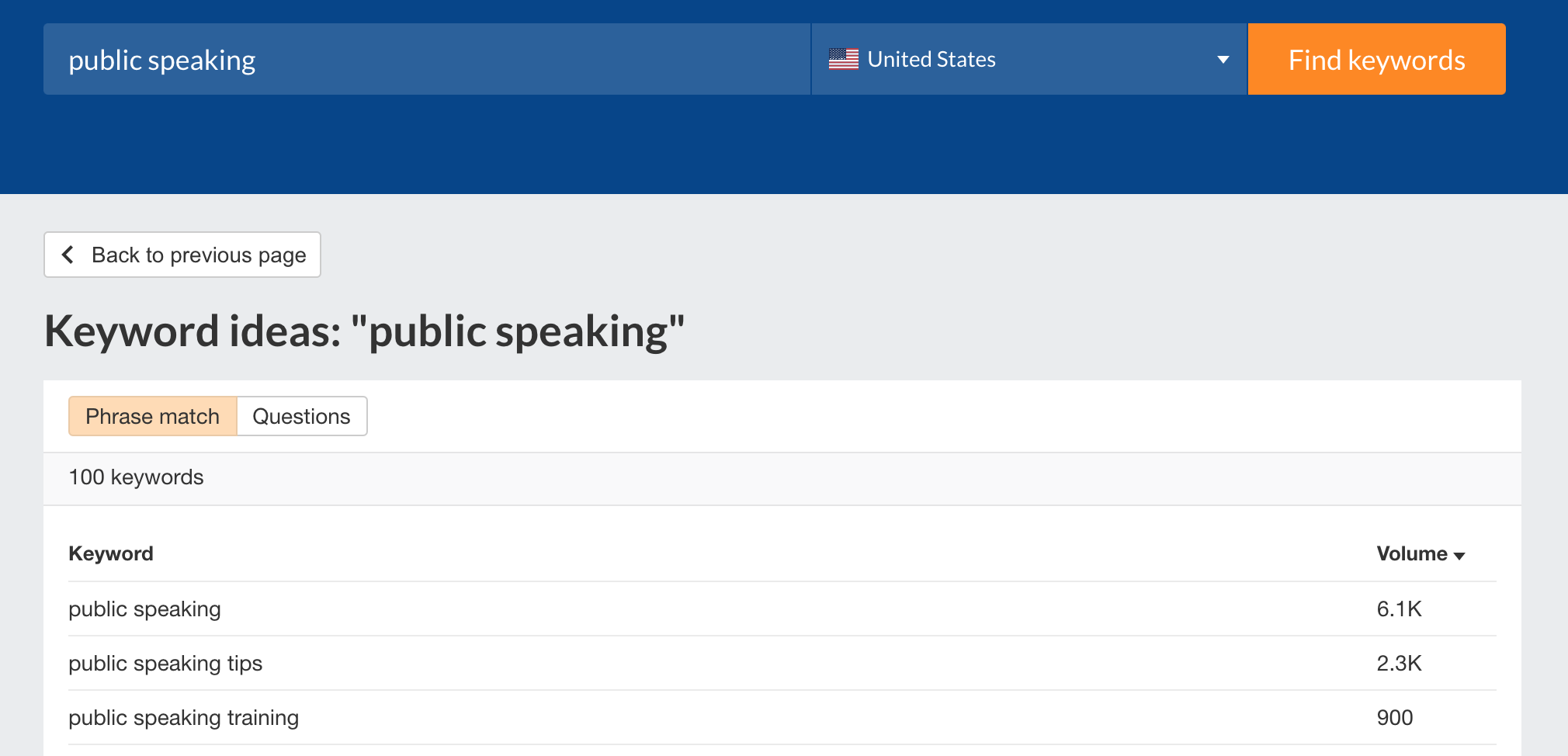
Another approach is to use similar keyword suggestion tools to generate ideas and then analyze them using Google's Keyword Planner, which we'll discuss next.
Got your keyword list ready? 🎉😎
Great! Now that we've assembled a list of potential keyword ideas, ideally reflecting what people are actively searching for, it's time to analyze them.
Typically, you should aim to identify both a primary and secondary keyword to optimize your video around.
The goal here is to identify keywords that you can realistically rank for while ensuring they still have sufficient search volume.
In other words, you don't want to invest your efforts in ranking for a keyword that only receives 20 monthly searches.
On the flip side, you also want to avoid wasting your resources trying to compete for a keyword that's already oversaturated.
Striking the right balance is key, and it's a common mistake made by beginners.
YouTubers generally fall into two categories
Beginners (Small budget):
If you're just starting out, consider targeting less competitive keywords, often referred to as long-tail keywords.
For these creators we recommend selecting keywords with at least 500-1,000 monthly searches.
Starting small and achieving tangible results is often more rewarding than aiming for the stars right away.
Once you become more experienced, you can gradually target more competitive keywords and scale up your efforts.
High Authority Channels (Big budget):
High authority channels are those with hundreds of thousands of subscribers, millions of views, and a longstanding presence on YouTube.
As a new YouTuber, it can be challenging to compete with these established channels unless you're willing to invest in paid promotions.
How to Analyze Your Keyword Ideas
There are several methods to analyze search volumes for your keyword ideas.
Below, we'll take a look at some of the most common ones.
1. Google Keyword Planner
Google used to provide precise search volume data, but now they offer estimates like ~100-1K or ~1-10K or ~100K-1M, which can be somewhat vague.
For beginners, we typically recommend targeting keywords with an average monthly search volume of ~100-1K or ~1-10K.
Here's how it works:
- Sign up for a Google AdWords account and set up an ad campaign (no actual payment is required).
- Use Google Keyword Planner to get estimated search volumes. Note that these volumes are based on Google Search, not YouTube.
- Click on "Get search volume and forecasts".
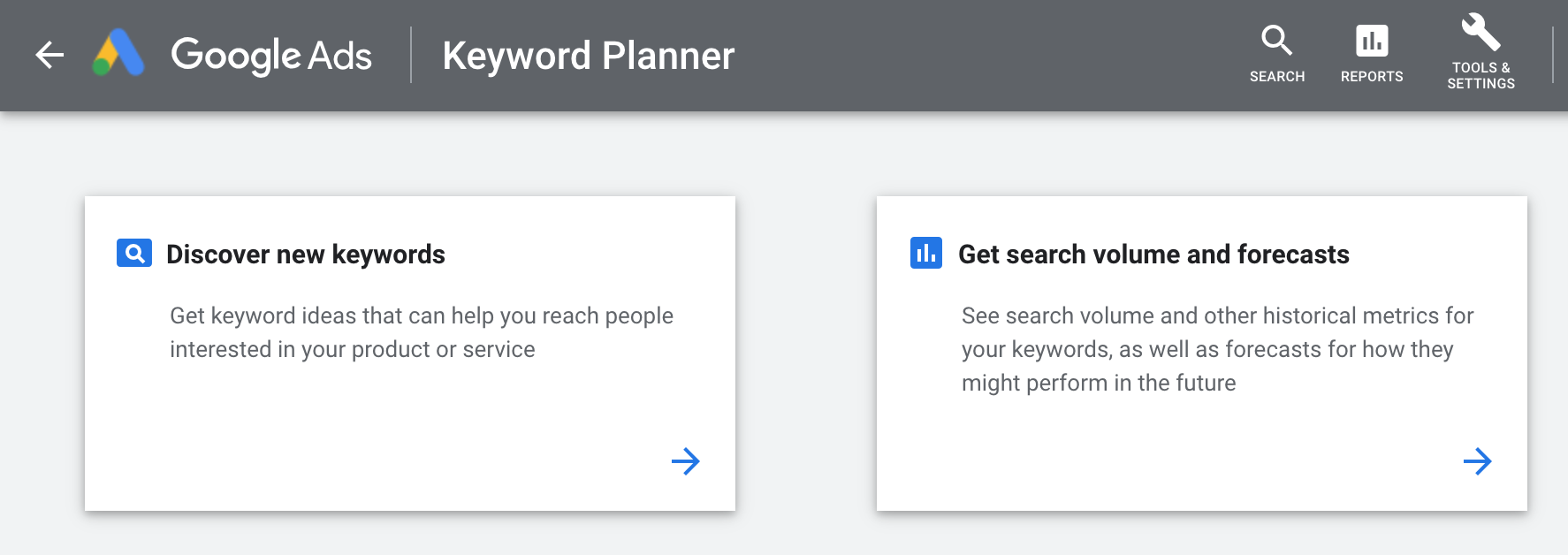
Enter your keyword ideas, and click "Get started."
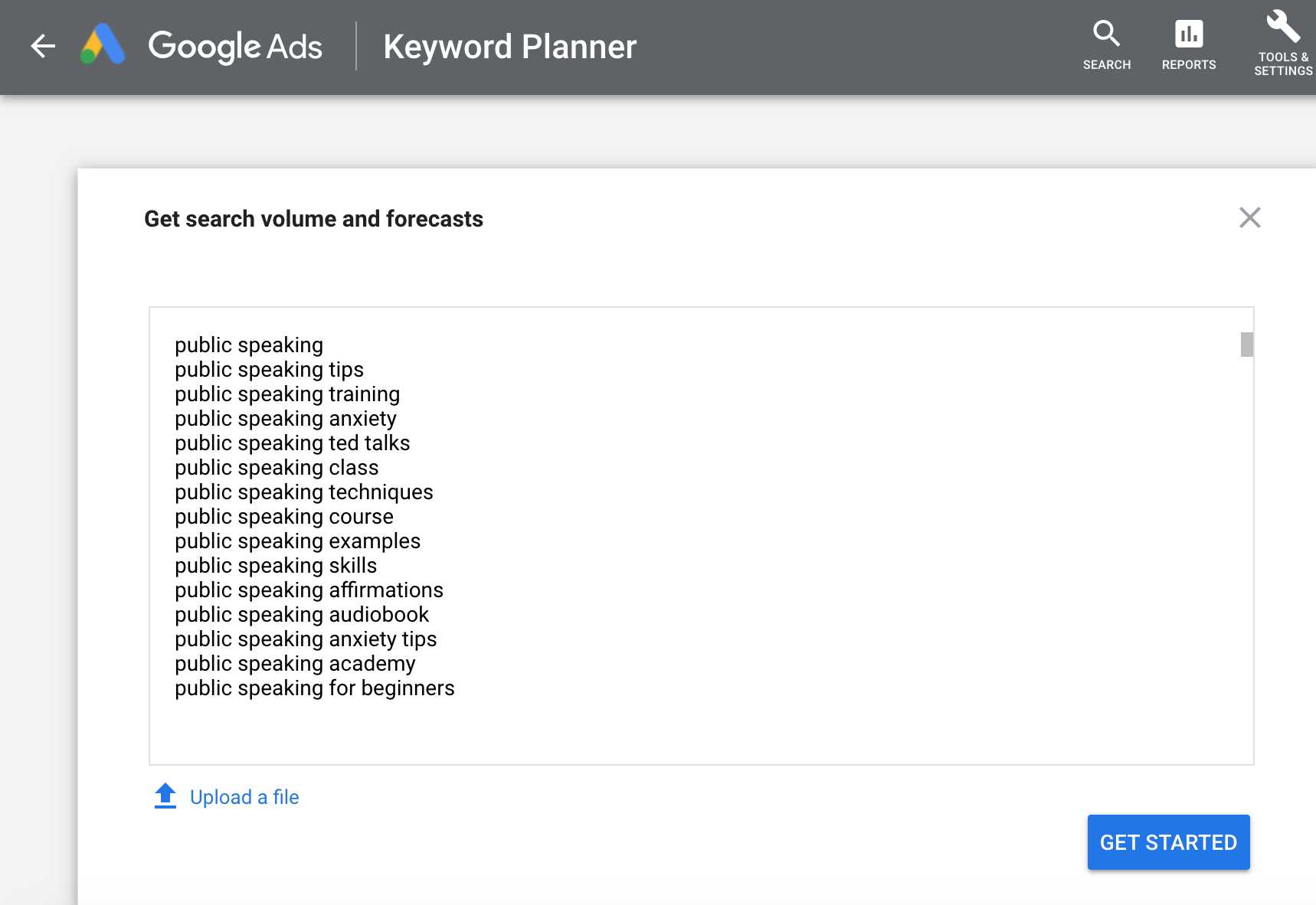
Sort the results by "Avg. monthly searches" and make sure to select "All locations" under "Locations".
You can adjust locations if you want to target specific countries or regions.
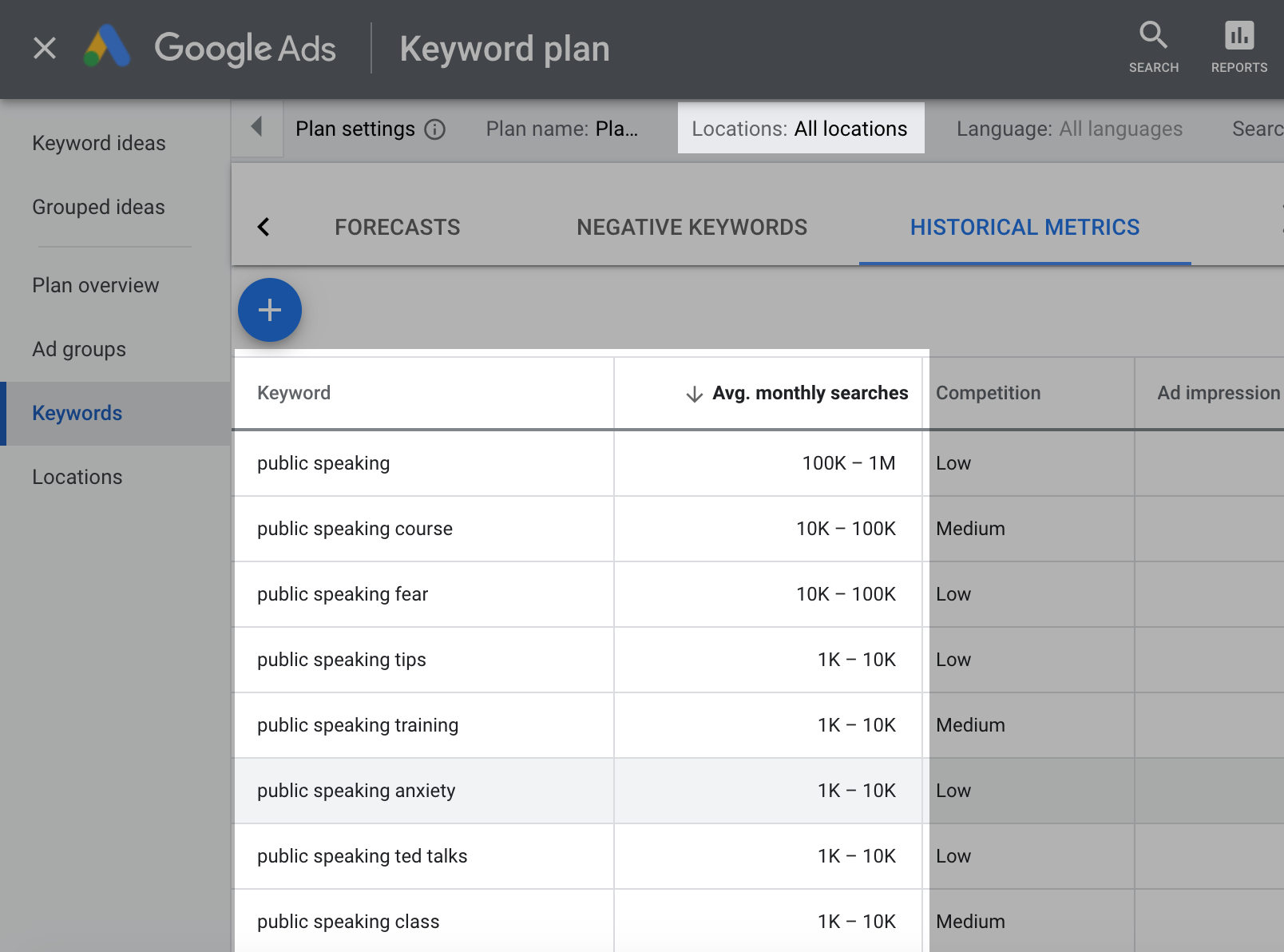
This data reveals important metrics, with "average monthly searches" being a key indicator.
For example, the keyword "public speaking" is highly competitive with an estimate of 100K-1M monthly searches, suggesting strong existing competition in this niche.
Long-tail keywords tend to have lower monthly searches, making them less competitive and more accessible for beginners.
2. Use a Keyword Tool
As previously discussed, utilizing a keyword tool is advantageous as it provides keyword ideas and search volumes simultaneously.
3. Examine the Top 10 results
We also recommend examining the Top 10 results on YouTube for your chosen keyword.
Create an Excel sheet to store values like views, likes, comments for each video, and subscriber counts.
This helps you gauge the performance of the top 10 results on YouTube and determine whether you can compete for the keyword.
Ideally, you should aim to match or outperform these numbers.
Fortunately, SocialPlus can also help you here through our cost-effective promotions.
You're Making Progress! 😎🙌
Congratulations! You've just completed the lesson on researching and analyzing keyword ideas.
As you start to see success in ranking for low-competition keywords, you can consider targeting more competitive ones and gradually expanding your reach.
However, remember that all these steps become ineffective if your video doesn't deliver value or keep viewers watching, which we'll discuss in the next lesson.
What's Up Next?
In our next lesson of our YouTube Growth Course, we'll look into the art of publishing a video that keeps your viewers engaged. This is also known as audience retention, a significant ranking factor on YouTube.
Did you know that you typically have only 10-15 seconds to convince the average viewer that your video is worth watching? It's a short window of time!
This is why mastering the art of creating engaging videos is crucial. The longer people watch your content, the better your video rankings will become.
Ultimately, YouTube aims to keep users on their platform for as long as possible so they can show more ads. If your content helps YouTube in achieving that goal, you'll be rewarded.
- 👉 You're here: Part 1. YouTube Keyword Research: How To Get More Views?
- Part 2. How To Create Engaging YouTube Videos That Rank Higher
- Part 3. YouTube SEO 101: How To Boost Your Videos Search Ranking
- Part 4. Effective YouTube Video Promotion: Strategies to Boost Reach
